4 Simple Techniques For Street Photographers
Table of ContentsGetting The Street Photographers To WorkThe Street Photographers DiariesStreet Photographers Can Be Fun For AnyoneThe Greatest Guide To Street PhotographersOur Street Photographers Ideas
Road professional photographers do not always have a social function in mind, yet they like to isolate and catch moments which may otherwise go undetected.Though he was influenced by a number of those who affected the street digital photographers of the 1950s and '60s, he was not mainly interested in catching the spirit of the road. The impulse to visually document individuals in public began with 19th-century painters such as Edgar Degas, douard Manet, and Henri de Toulouse-Lautrec, that functioned side by side with digital photographers attempting to capture the significance of urban life.
As a result of the comparatively primitive innovation available to him and the lengthy direct exposure time required, he had a hard time to catch the pressure of the Paris roads. He try out a series of photographic methods, attempting to discover one that would certainly permit him to record activity without a blur, and he found some success with the calotype, patented in 1841 by William Henry Fox Talbot. Unlike Atget, professional photographer Charles Marville was worked with by the city of Paris to develop an encyclopaedic document of Haussmann's urban planning project as it unfolded, thus old and new Paris. While the professional photographers' subject was essentially the exact same, the results were noticeably various, showing the effect of the digital photographer's bent on the personality of the pictures he created.
Given the fine top quality of his pictures and the breadth of material, architects and artists typically acquired Atget's prints to make use of as reference for their own work, though industrial rate of interests were rarely his major inspiration. Rather, he was driven to picture every last residue of the Paris he loved. The mingled passion and urgency of his objective luster through, leading to photos that tell his own experience of the city, high qualities that anticipated street photography of the 20th century.
The Street Photographers Diaries
They expose the city through his eyes. His job and fundamental understanding of digital photography as an art form acted as motivation to generations of digital photographers that adhered to. The future generation of road professional photographers, though they likely did not refer to themselves therefore, was introduced by the photojournalism of Hungarian-born professional photographer Andr Kertsz.
Unlike his peers, Brassa used a larger-format Voigtlnder camera with a much longer exposure time, compeling him to be much more computed and thoughtful in his practice than he could have been if using a Leica. (It is assumed that he may not have had the ability to afford a Leica back then, but he did, nonetheless, use one in the late 1950s to take colour photos.) Brassa's photographs of the Paris abyss lit up by artificial light were a discovery, and the collection of the series that he published, (1933 ), was a significant success.
Cartier-Bresson was a champ of the Leica camera and one of the very first photographers to maximize its abilities. The Leica permitted the professional photographer to connect with the surroundings and to capture moments as they occurred. Its reasonably small size likewise assisted the digital photographer discolor right into the history, which was Cartier-Bresson's preferred method.
Street Photographers Fundamentals Explained
It is as a result of this essential understanding of the art of image taking that he is typically attributed with uncovering the tool all over once again roughly a century because its innovation. He took photos for greater than a half century and affected generations of digital photographers to trust their eye and instinct in the minute.
These are the concerns I shall attempt to address: And afterwards I'll leave you with my own definition of road digital photography. Yes, we do. Let's kick off with specifying what a meaning is: According to (Street Photographers) it is: "The act of defining, or of making something precise, distinctive, or clear"
No, absolutely not. The term is both limiting and deceiving. Sounds like a street digital photography need to be pictures of a roads right?! And all road professional my link photographers, except for a small number of outright beginners, will totally appreciate that a road is not the crucial component to road photography, and in fact if it's a photo of a road with perhaps a couple of uninteresting individuals doing absolutely nothing of interest, that's not road photography that's a picture of a street.
An Unbiased View of Street Photographers
He makes a legitimate point don't you assume? However, while I concur with him I'm not exactly sure "candid public photography" will capture on (although I do sort of like the term "honest photography") due to the fact that "street photography" has been around for a very long time, with many masters' names connected to it, so I believe the term is right here to remain.
You can fire at the coastline, at a festival, in an alley, in a park, you could try this out in a piazza, in a cafe, at a gallery or art gallery, in a metro station, at an event, on a bridge, under a bridge ...
Yes, I'm afraid we worried no choice! Without policies we can not have a definition, and without a meaning we don't have a style, and without a style we don't have anything to specify what we do, and so we are stuck in a "guidelines meaning category" loop!
Street Photographers for Beginners
